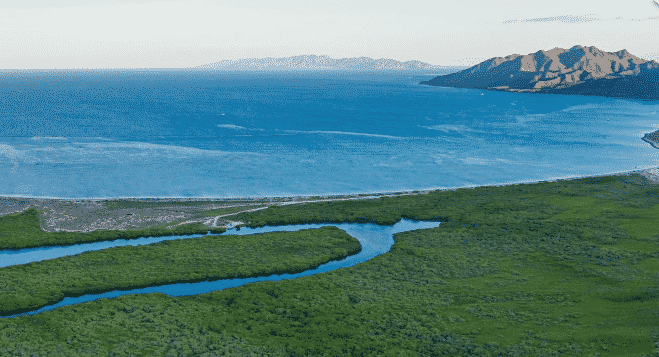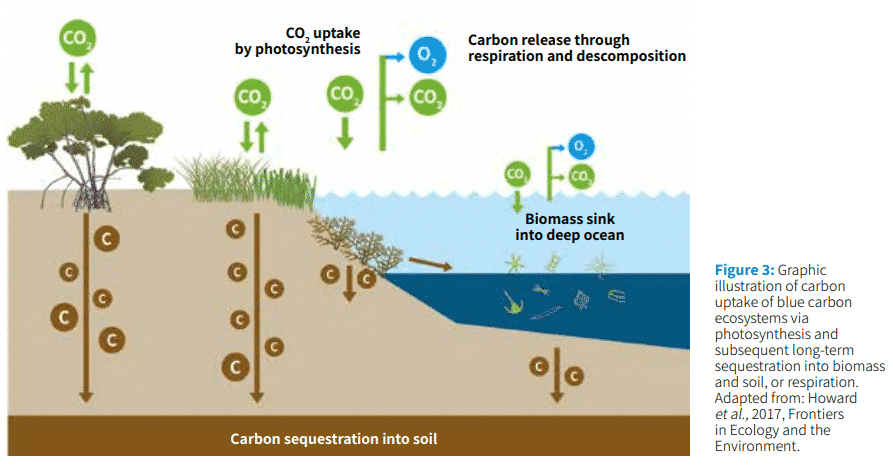What is Blue Carbon?
Blue carbon credits are created by the growth and conservation of carbon-absorbing plants, such as mangrove forests and their associated marine habitat.
Blue Carbon refers to the carbon stored in coastal ecosystems like mangroves, seagrasses, and salt marshes.
These ecosystems cover just 1% of the ocean floor but can store up to 10 times more carbon per unit area than terrestrial forests.
Blue Carbon is so-called because it is stored in marine or coastal living organisms and the sediments beneath them.
Blue Carbon ecosystems are vital for the health of our planet. They not only store carbon but also provide essential services such as water purification, coastal protection, and habitat for marine life.
Over the past decade scientists have discovered that seagrass meadows, tidal marshes and mangrove forests are among the most intensive carbon sinks in the world. This means blue carbon offsets can remove enormous amounts of greenhouse gases.
A blue carbon offset project should have its carbon credits trade at a premium.
This is because of the large positive second-order effects such as the positive effects on corals, algae, and marine biodiversity (e.g. sharks, whales, sea turtles) that have been so negatively impacted by activities such as over-fishing and farming.
- Mangroves Store 10x more carbon than terrestrial forests (Source: Kauffman et al, 2018)
Yes, forests can grow in the ocean. Examples include the mangrove forests in sea bays, such as Magdalena Bay in Baja California Sur, Mexico.

Mangroves are trees (about 70 percent underwater, 30 percent above water) that have evolved to be able to survive in flooded coastal environments where sea water meets fresh water and the resulting lack of oxygen makes life impossible for other plants.
- Mangroves cover just 0.1% of earth’s surface (Source: FAO, 2003)
Mangrove trees create shelter and food for numerous species such as sharks, whales, and sea turtles. Mangrove forests are a valuable marine ecosytem.
Second Order Effects of Blue Carbon Credits
Other positive second-order effects of mangrove forests include their importance as a pollution filter, reducing coastal wave energy and reducing the impacts from coastal storms and extreme events. Blue carbon systems trap sediment which support root systems for plants. This accumulation of sediment over time can enable coastal habitats to keep pace with rising sea levels.
All this can be calculated into insurance premiums, and lower-cost premiums are good for business and residents. These are all free second-order effects. To put it in perspective, natural disasters and extreme weather events created over $270 billion worth of economic losses in 2020. It is absolutely in the best interest of citizens and insurance companies to mitigate the effects of climate change.
Coastal wetlands and mangrove forests will become an ever-increasing sector for carbon credit generation. That is because mangrove forests and coastal wetlands sequester carbon at a rate that is up to ten times greater than mature tropical forests.
Because the carbon is sequestered and stored below water in aquatic forests and wetlands, it is stored for more than ten times longer than in tropical forests.
- The significant positive second-order effects attributed to each blue carbon credit are why many investors believe it will trade at a premium to other carbon credits.
Blue Carbon and the Food Footprint
There is a land-use carbon footprint of 1440 kg CO2e for every kilogram of beef and 1603 kg CO2e for every kilogram of shrimp produced on lands formerly occupied by mangroves. A typical steak and shrimp cocktail dinner would burden the atmosphere with 816 kg CO2e.
It is estimated that over 1 billion tons of carbon dioxide is released annually from degraded coast ecosystems.
There are around fourteen million hectares of mangrove aquaforests on earth today and they’re under attack by the deforestation practices caused by intense shrimp farming
Are the shrimp you eat part of the problem? Soon, these shrimp will be labeled, and consumers will know and be required to cover the offset costs for the environmental damage.
To put things into perspective, 14 million acres of wetlands will absorb as much carbon out of the atmosphere as if all of California and New York State were covered in Tropical Rainforest.
Think of Blue Carbon as the “high grade” gold mine at the surface.
With the economic value of Blue Carbon credits and the technology that will enable Carbon Rangers to preserve forests and wildlife, expect entrepreneurs to expand the Carbon Ranger program to mangrove forests across the globe. This will be a step forward and a small part of solving the climate emergency.
These are just a few of the examples of how carbon credits will be created to enhance stakeholder capitalism.
Oceanic Blue Carbon
In addition to coastal blue carbon mentioned above, Oceanic blue carbon is stored deep in the ocean within phytoplankton and other open ocean biota.
The infographic below shows the typical blue carbon ecosystem

There are many factors that influence carbon capture by blue carbon ecosystems. These include:
- Location
- Depth of water
- Plant species
- Supply of nutrients
Improving blue carbon ecosystems can significantly improve the livelihoods and cultural practices of local and traditional communities. In addition, restoring blue carbon regions provides enormous biodiversity benefits to both marine and terrestrial species.
– CarbonCredits Editor
